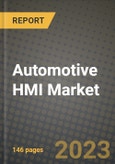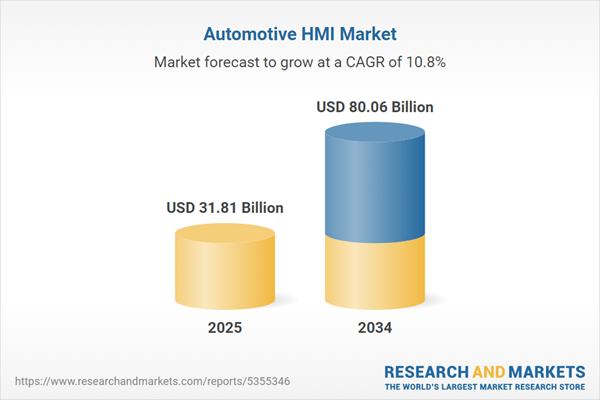Automotive HMI Market
The automotive HMI (Human-Machine Interface) market spans in-cabin display clusters, center stacks, passenger displays, HUDs/AR-HUDs, steering/console controls, haptics, microphones/voice stacks, driver monitoring, and cockpit domain controllers that orchestrate UX across OS layers and sensor inputs. OEMs are converging on software-defined architectures with Ethernet backbones, zonal E/E, and consolidated SoCs that run mixed-criticality workloads (instrumentation, IVI, ADAS visualizations) under hypervisors. UX priorities include glanceability, minimal cognitive load, and safety-compliant modalities - visual, voice, and tactile - while enabling commerce, infotainment, and personalization via cloud identities and app ecosystems. Differentiation centers on graphic fidelity (3D/real-time rendering, map-centric UIs), multimodal assistants (LLM-enhanced voice, on-device AI for latency/privacy), and adaptive layouts responsive to driving state and regional norms. Suppliers compete on toolchains, middleware, and compliance (functional safety, cybersecurity), alongside haptic/lighting technologies that provide tactile/ambient cues. Headwinds include feature creep and distraction risk, OTA complexity, certification burdens, and fragmentation across silicon, OS, and app frameworks. Opportunities arise from AR-HUD navigation and ADAS explainability, cabin sensing for safety/wellness, and harmonized design systems that scale from entry to premium trims. As vehicles become rolling digital platforms, winning HMI strategies balance brand expression with safety, accessibility, and lifecycle agility - shipping fast, iterating via OTA, and maintaining trust through resilient, privacy-aware experiences that meet regulatory expectations while delighting users with intuitive, context-aware interactions.Automotive HMI Market Key Insights
- Software-defined cockpit as the control point: Domain/zonal controllers consolidate cluster, IVI, and ADAS visualization on shared SoCs; hypervisors isolate safety-critical apps from infotainment, reducing BOM while enabling faster feature iteration and cross-trim reuse.
- Multimodal by design, not bolt-on: Voice, touch, rotary/hard keys, and haptics are orchestrated so primary tasks need minimal visual attention; wake-word accuracy, barge-in, and context memory determine real-world adoption across accents and cabin noise.
- AR-HUDs move from wow to utility: Lane-level guidance, hazard highlighting, and ADAS rationale projected at road plane reduce eye travel; success hinges on combiner optics, luminance in sunlit scenarios, and rock-solid registration under vibration and heat.
- Driver monitoring as UX governor: Eye-gaze, head pose, and fatigue signals adapt UI density, prompt hands-on/eyes-on, and gate certain features; privacy-preserving, on-device processing mitigates regulatory and consumer concerns.
- Design systems that scale: Tokenized design languages (type, spacing, color, motion) and component libraries ensure consistency across clusters, center stacks, wearables, and companion apps - cutting development time and localization rework.
- Latency and frame consistency matter: Navigation and ADAS overlays require 60+ fps and < 50 ms interaction latency; GPU scheduling, scene graph optimization, and efficient map/vector pipelines shape perceived quality and reduce motion sickness.
- Voice gets smarter - and safer: LLM-enhanced assistants handle multi-intent commands (“navigate home and precondition cabin”) with correction loops; guardrails and offline fallbacks keep safety-critical interactions deterministic under poor connectivity.
- Haptics and light as silent tutors: Localized vibration, force feedback, and ambient light rails convey confirmations and warnings without noise; tunable amplitudes and frequencies support accessibility and reduce startle in sensitive users.
- Cyber and safety compliance as table stakes: Secure boot, key management, intrusion detection, and over-the-air delta updates pair with ISO 26262/21434 processes; blue/green deployment and rollback plans protect uptime and user trust.
- Post-sale UX as revenue engine: OTA feature drops, subscriptions, and app storefronts monetize seats, themes, assistants, and ADAS visual add-ons; analytics-powered A/B tests optimize flows while respecting data minimization and consent norms.
Automotive HMI Market Reginal Analysis
North America
Emphasis on large displays, connected services, and ADAS visualization tied to highway assistance features. Consumers expect seamless phone integration plus native maps/media with voice-first control. OTA maturity and subscription-readiness are procurement criteria; pickup/SUV segments push glove-friendly controls and robust sunlight-readable UIs. Regulatory scrutiny around distraction and data privacy informs conservative interaction patterns and clear ADAS explainability in the HMI.Europe
Safety, regulatory compliance, and ergonomic rigor shape HMIs with balanced use of physical controls for driving-critical functions. Premium brands lead in AR-HUDs, refined haptics, and cohesive design languages across trims. Embedded navigation with live data is standard; privacy-by-design and cybersecurity certifications weigh heavily. Multi-language, cross-border map quality and EV route planning (charging-aware) are must-haves for long-distance users.Asia-Pacific
Fast innovation cycles and super-app ecosystems drive feature-rich HMIs, with strong demand for voice in local languages and AI personalization. China accelerates large-screen cockpits, AR-HUD pilots, and in-cabin commerce; Japan/Korea emphasize refinement, latency control, and safety rigor. Price bands range widely - scalable design systems and silicon choices enable OEMs to cascade premium UX to mass segments while maintaining performance.Middle East & Africa
Hot-climate robustness (brightness, thermal management) and Arabic/English bilingual UX are priorities in premium imports and regional OEMs. Navigation must handle sparse addressing and off-road use; dust tolerance and reliable offline modes matter. Luxury buyers expect concierge-style voice services and deep smartphone mirroring, while fleet and ride-hail operators value durable, distraction-checked HMIs with remote diagnostics and OTA upkeep.South & Central America
Value-focused trims require efficient HMIs: smaller but legible screens, simplified menus, and reliable phone projection. Urban traffic conditions elevate navigation clarity and real-time alerts; multilingual support (Spanish/Portuguese) and offline maps are critical. OEMs prioritize cost-optimized domain controllers and durable physical controls, with gradual introduction of connected services as coverage and ARPU improve.Automotive HMI Market Segmentation
By Product
- Voice Recognition System
- Rotary Controllers
- Gesture Recognition
- Touch Screen Display
- Instrument Cluster Display
- Steering Mounted Control System
- Head-Up Display
- Multifunction Switches
By Access
- Standard HMI System
- Multimodal HMI System
By Technology
- Visual Interface
- Acoustic Interface
- Others
By Vehicle
- Passenger Cars
- Light Commercial Vehicles
Key Market players
Continental AG, Robert Bosch GmbH, DENSO Corporation, Panasonic Automotive Systems, Harman International (Samsung), Visteon Corporation, Aptiv, Valeo, Nippon Seiki Co., Ltd., Hyundai Mobis, Desay SV Automotive, Alps Alpine Co., Ltd., BlackBerry QNX, Elektrobit, LuxoftAutomotive HMI Market Analytics
The report employs rigorous tools, including Porter’s Five Forces, value chain mapping, and scenario-based modelling, to assess supply-demand dynamics. Cross-sector influences from parent, derived, and substitute markets are evaluated to identify risks and opportunities. Trade and pricing analytics provide an up-to-date view of international flows, including leading exporters, importers, and regional price trends.Macroeconomic indicators, policy frameworks such as carbon pricing and energy security strategies, and evolving consumer behaviour are considered in forecasting scenarios. Recent deal flows, partnerships, and technology innovations are incorporated to assess their impact on future market performance.
Automotive HMI Market Competitive Intelligence
The competitive landscape is mapped through proprietary frameworks, profiling leading companies with details on business models, product portfolios, financial performance, and strategic initiatives. Key developments such as mergers & acquisitions, technology collaborations, investment inflows, and regional expansions are analyzed for their competitive impact. The report also identifies emerging players and innovative startups contributing to market disruption.Regional insights highlight the most promising investment destinations, regulatory landscapes, and evolving partnerships across energy and industrial corridors.
Countries Covered
- North America - Automotive HMI market data and outlook to 2034
- United States
- Canada
- Mexico
- Europe - Automotive HMI market data and outlook to 2034
- Germany
- United Kingdom
- France
- Italy
- Spain
- BeNeLux
- Russia
- Sweden
- Asia-Pacific - Automotive HMI market data and outlook to 2034
- China
- Japan
- India
- South Korea
- Australia
- Indonesia
- Malaysia
- Vietnam
- Middle East and Africa - Automotive HMI market data and outlook to 2034
- Saudi Arabia
- South Africa
- Iran
- UAE
- Egypt
- South and Central America - Automotive HMI market data and outlook to 2034
- Brazil
- Argentina
- Chile
- Peru
Research Methodology
This study combines primary inputs from industry experts across the Automotive HMI value chain with secondary data from associations, government publications, trade databases, and company disclosures. Proprietary modeling techniques, including data triangulation, statistical correlation, and scenario planning, are applied to deliver reliable market sizing and forecasting.Key Questions Addressed
- What is the current and forecast market size of the Automotive HMI industry at global, regional, and country levels?
- Which types, applications, and technologies present the highest growth potential?
- How are supply chains adapting to geopolitical and economic shocks?
- What role do policy frameworks, trade flows, and sustainability targets play in shaping demand?
- Who are the leading players, and how are their strategies evolving in the face of global uncertainty?
- Which regional “hotspots” and customer segments will outpace the market, and what go-to-market and partnership models best support entry and expansion?
- Where are the most investable opportunities - across technology roadmaps, sustainability-linked innovation, and M&A - and what is the best segment to invest over the next 3-5 years?
Your Key Takeaways from the Automotive HMI Market Report
- Global Automotive HMI market size and growth projections (CAGR), 2024-2034
- Impact of Russia-Ukraine, Israel-Palestine, and Hamas conflicts on Automotive HMI trade, costs, and supply chains
- Automotive HMI market size, share, and outlook across 5 regions and 27 countries, 2023-2034
- Automotive HMI market size, CAGR, and market share of key products, applications, and end-user verticals, 2023-2034
- Short- and long-term Automotive HMI market trends, drivers, restraints, and opportunities
- Porter’s Five Forces analysis, technological developments, and Automotive HMI supply chain analysis
- Automotive HMI trade analysis, Automotive HMI market price analysis, and Automotive HMI supply/demand dynamics
- Profiles of 5 leading companies - overview, key strategies, financials, and products
- Latest Automotive HMI market news and developments
Additional Support
With the purchase of this report, you will receive:- An updated PDF report and an MS Excel data workbook containing all market tables and figures for easy analysis.
- 7-day post-sale analyst support for clarifications and in-scope supplementary data, ensuring the deliverable aligns precisely with your requirements.
- Complimentary report update to incorporate the latest available data and the impact of recent market developments.
This product will be delivered within 1-3 business days.
Table of Contents
Companies Mentioned
- Continental AG
- Robert Bosch GmbH
- DENSO Corporation
- Panasonic Automotive Systems
- Harman International (Samsung)
- Visteon Corporation
- Aptiv
- Valeo
- Nippon Seiki Co. Ltd.
- Hyundai Mobis
- Desay SV Automotive
- Alps Alpine Co. Ltd.
- BlackBerry QNX
- Elektrobit
- Luxoft
Table Information
| Report Attribute | Details |
|---|---|
| No. of Pages | 160 |
| Published | November 2025 |
| Forecast Period | 2025 - 2034 |
| Estimated Market Value ( USD | $ 31.81 Billion |
| Forecasted Market Value ( USD | $ 80.06 Billion |
| Compound Annual Growth Rate | 10.8% |
| Regions Covered | Global |
| No. of Companies Mentioned | 15 |









